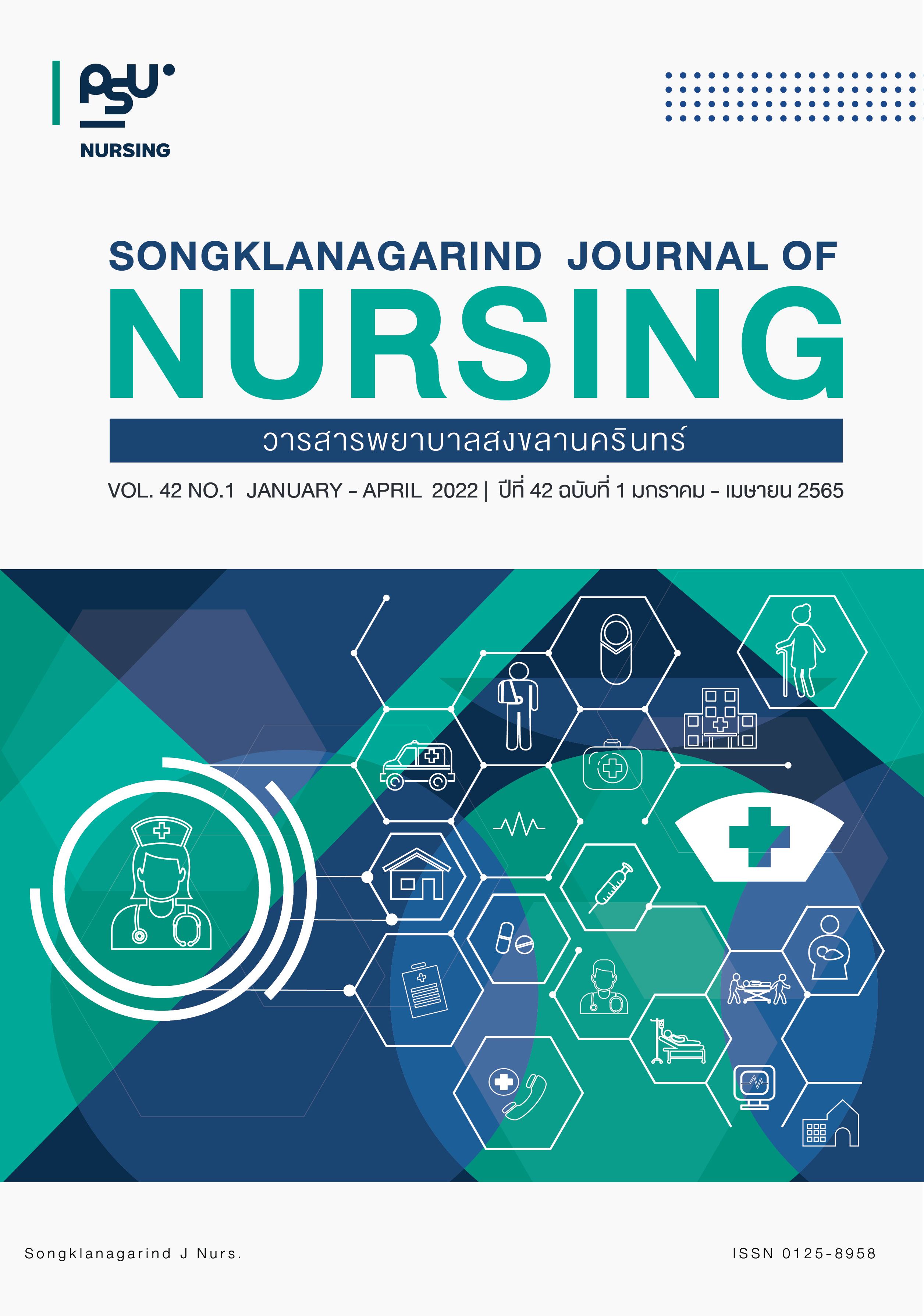Meaning of Patient Safety through Esthetic Expression of Nursing Students, Prince of Songkla University
Main Article Content
Abstract
Objective: Patient safety is the vital goal of health care delivery. This qualitative study aimed to explore the meaning of patient safety through esthetic expression (drawing) of nursing students, Faculty of Nursing, Prince of Songkla University. Methods: Key Informants were 30 third-year students, Faculty of Nursing, Prince of Songkla University. The research tools were 1) drawing guidelines and 2) semistructured interview questions to explain the connection between the picture and the definition of patient safety. The data were collected by using the drawn picture and semi-structured interviewing. Results: Data
were analyzed by using content analysis. Four meanings of patient safety through esthetic expression were emerged: 1) patient safety is the nurse’s consciousness and commitment to monitor unsafe incidence; 2) patient safety is the practice based on nursing care standard; 3) caring for patient’s safety is like the way caring for our own family and 4) patient safety occurs in collaborative practices. Conclusion: The finding of this study can provide guidance for nursing lecturers in the development of teaching and learning strategies to offer students with a wide range of patient safety experiences and cultivate patient safety values which are the basis of safety culture in nursing profession.
Article Details

This work is licensed under a Creative Commons Attribution-NonCommercial-NoDerivatives 4.0 International License.
References
The Healthcare Accreditation Institute (Public Organization). Patient safety goal: SIMPLE Thailand 2018. Nontaburee: Famous and successful; 2018. Thai.
Thiangchanya P. Patient safety management for nurse administrators. Songkhla: Chanmuang Press; 2022. Thai.
World Health Organization. Patient safety curriculum guides multi-professional edition [Internet]. Geneva: WHO press; 2011 [cited 2018 Jan 9]. Available from: http://apps.who.int/iris/bitstream/10665/44641/1/9789241501958_eng.pdf.
Mansour M. Current assessment of patient safety education. Br J Nurs. 2012; 21(9): 536-43. doi: 10.12968/bjon.2012.21.9.536.
Carper BA. Fundamental patterns of knowing in nursing. ANS Adv Nurs Sci. 1978; 1(1): 13-23. doi: 10.1097/00012272-197810000-00004.
Chinn PL, Maeve MK, Bostick C. Aesthetic inquiry and the art of nursing. Sch Inq Nurs Pract. 1997; 11(2): 83-96.
Khumpho P, Chintanadilok N, Payakkaraung S, et al. Painrelieving effect of music therapy on school age children having received bone marrow aspiration. JTNMC. 2014; 29(1): 82-94. Thai.
Perkins A. Music and art therapy: Approaching patient care with a different stroke. Nursing made Incredibly Easy! May [Internet]. 2020 [cited 2021 Feb 15].Available from: https://journals.lww.com/nursingmadeincrediblyeasy/fulltext/2020/05000/music_and_art_therapy_approaching_patient_care.5.aspx
Literat L. “A pencil for your thoughts”: Participatory drawing as a visual research method with children and youth. IJQM. 2013; 12: 84-98. doi: https://doi.org/10.1177/160940691301200143.
Sandoval BS. Photovoice an exercise of emancipation for nursing. Am. J. Nurs. Res. 2017; 3(1): 1-4.
Moorman M, Hensel D. Using visual thinking strategies in nursing education. Nurse Educ. 2016; 41(5): 5-6. doi: 10.1097/NNE.0000000000000185.
Dolatabadi F, Ziaeirad M. The relationship between critical thinking and patient safety culture in the nurses. [Abstract]. JNE. 2021; 10(2): 1-12.
Chan ZC. Drawing in nursing PBL. Nurse Educ Today. 2013; 33(8): 818-22. doi: 10.1016/j.nedt.2012.02.018.
Blomqvist L, Pitkälä K, Routasalo P. Images of loneliness: Using art as an educational method in professional training. [Abstract]. J Contin Educ Nurs. 2021; 38(2): 89-93. doi: https://doi.org/10.3928/00220124-20070301-05.
Schwind JK, Lindsay GM. Arts-informed narrative inquiry as a practice development methodology in mental health. IPDJ. 2015; 5(1): 1-12. doi: https://doi.org/10.19043/ipdj.51.005.
Kongsuwan W, Apichato A, Maneewat K. Carin as nursing: Aesthetic expression of nursing students. Songklanagarind J
Nurs. 2018; 41(2): 1-12. Thai.
Matchim Y, Thongthawee B, Nirattharadorn M, et al. Experiences of learning in the course of development of nursing profession and nursing science: esthetic expression of first-year nursing students. Songklanagarind J Nurs. 2021; 41(2): 1-10. Thai.
Thongkaew S, Thongsuk P, Thiangchanya P. Patient safety awareness among novice nurses working in general hospitals in Southern Thailand. SCNJ. 2018; 5(1): 62-73. Thai.
Juliato R. Thaingchanya P. Boonyoung N. Nurses’ patient safety competencies in Aceh Province, Indonesia. Nurse Media J. Nurs. 2014; 4(1): 659-70. doi: 10.14710/nmjn.v4i1.6704.
Husserl E. The phenomenology of internal timeconsciousness. 2 nd ed [Internet]. Bloomington: Indiana University Press; 2019 [cited 2020 Dec 15]. Available from: shorturl.at/crRS6
Shies HF, Shanon SE. Three approaches to content analysis content analysis. Qual Health Res. 2005; 15: 2077-88. doi: 10.1177/1049732305276687.
Lincoln YS, Guba EG. Naturalistic inquiry. Beverly Hills, CA: SAGE; 1985.
Kim L, Lyder CH, Mcnees-Smith D, et al. Defining attribute of patient safety through a concept analysis. J Adv Nurs. 2015; 71(11): 2490-503. doi: 10.11112jan.12715.
Vaismoradi M, Tella S, Logan AP, et al. Nurses’ adherence to patient safety principles: A systematic review. Int. J. Environ. Res. Public Health. 2020; 17(6): 1-15. doi: 10.3390/ijerph17062028.
Thiangchanya P, Peeravud J, Thapattaraporn M, et al. Nurses’ role in enhancing patient engagement in safety. Songklanagarind J Nurs. 2016; 36(3): 247-60. Thai.
Siwawut J, Thiangchanya P, Thongsuk P. Non-technical skills of perioperative nurses for patient safety in tertiary hospital, Thailand. Nursing J. 2020; 47(4): 458-69. Thai.
Bunditlerdrak C, Thiangchanya P, Boonyoung N. Effective collaboration in operating rooms of University Hospitals in Thailand: The 7 Components and 43 Elements of a Structured Practice. SCNJ. 2022; 9(1): 186-98. Thai.
Weatherford HB, Viveiros AJ. Senior nursing students’ perspectives on safety competencies: an end of program outcome evaluation. Nurs Educ Perspect. 2016; 36(3): 182-4. doi: 10.5480/13-1182.


